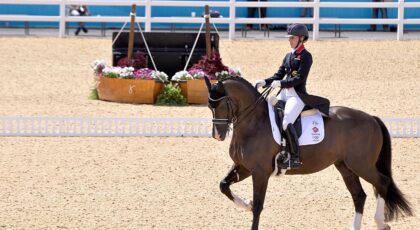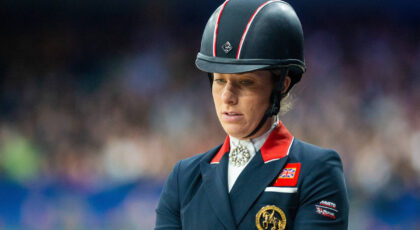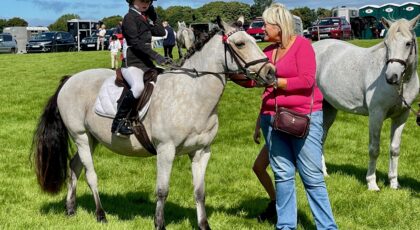The best part of the 2019 Midwest Horse Fair’s dressage competition was the variety in the ring.
In the strangely plush seats of the Coliseum, I watched fancy purebreds and rescue horses, college students and retirees, pros and amateurs all ride their tests below.
Yet the thing that I haven’t been able to shake since that show in April is the body diversity. Riders were short and tall, thin and plus size. Each competitor had enough balance, skill, and fitness to perform, some the most difficult movements in the sport.
This variety is a testament to the capacity of the human body, but also to the diversity of body types—a fact popular culture conveniently brushes under the carpet. The average size of models and actresses on TV ranges from size zero to six. The average American woman is a size 16. After attending many horse shows, horse expos, breed club meetings, and 4H events, it seems that this holds true of the horse industry as well.
I am one of these size 16 women and I’ve been keenly aware of the language of erasure since The Little Mermaid’s impractical waist graced the cover of my VHS tape.
If women and sometimes men do not fall into the prescribed body type of fit and thin, we are taught we are allowed to exist only if we are smaller, quieter, and flatter. If we can’t force our bodies to do this perceived norm, we are told it’s then preferable that we just don’t leave the house at all. If we do go out in public, then we better sit in the back, we better be polite, we better be abstaining from sugar and using our gym memberships. We must be good fat.
This narrative of “fitting-in” doesn’t just hurt those of us who can’t pass as thin. Diet culture, fatphobia, and the language they inhabit directly contribute to the staggering rise of eating disorders, including bulimia, anorexia, and binge eating.
Erasure and eating disorders are alive and well in the equine industry too. If I want a pair of breeches that fit, I better order them online. If I want to see people that look like me on horses, I sure as heck won’t find them modelling Wranglers jeans or posed in a perfect two point on expensive sale horse photos. The 20% suggested weight limit on horses is something I am always aware of.
I have even had desperate emails from strangers, who read my work and feared for horse crazy girls in their lives who have stopped eating and have started to vanish.
I too have been a product and creator of erasure. I have been overly polite and hid behind the camera instead of stepping in front of it. “Yes, you get on the horse,” I have said to someone smaller after I have put months of training into a horse. “We need a few photos.”
Years and years of being programmed to hate my body takes years and years of undoing. I now know I can’t hate myself into fitting the standard. This standard has more to do with colonialism and class then it does my actual health or riding ability. It is also a big abscess of a lie. Weighing less won’t actually make me happier, more accepted, or more loved, it will just make me weigh less.
So I have another strategy, dear reader.
Take up space.
Exist.
Insist.
Insist on more images of equestrians who look like you. Insist on pants that fit and boots that zip up the calf. Insist on trainers, breeders and other professionals who have horses that fit your body, who are willing to train you, and who understand the fact that the only thing shame has ever been good for is remembering to latch the gate after turnout.
And if they don’t, find someone else who does and give them your money instead.
This insisting isn’t just for plus size riders like me, but also for disabled riders, minority riders, LGBTQ+ riders and anyone else, who doesn’t neatly fit the status quo.
It’s been two years since I published “Fat Girl Riding” here at Horse Network and I am still fat. I still struggle with my body, but since I wrote that piece, I have learned that same body deserves admiration and respect. It walks eight miles a shift on concrete floor for one job, and then moves back and forth helping students at another. It does flip turns at the end of the swimming pool, it trains dressage and it runs around the arena doing groundwork.
It deserves the space it takes up, and so I am going to insist on doing exactly that.
About the Author
Gretchen Lida is an essayist and an equestrian. Her work has appeared in The Washington Post, The Rumpus, the Los Angeles Review of Books, and many others. She is also a contributing writer to Book Riot and the Washington Independent Review of Books and currently working on her first book. She teaches composition in Illinois, lives in Chicago, and is still a Colorado native. Find her on Twitter at @GC_Lida.




 June 12, 2019
June 12, 2019 




























